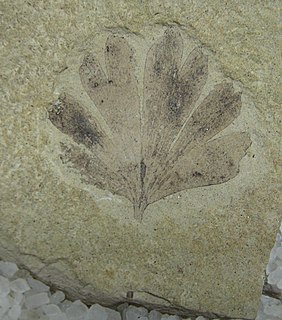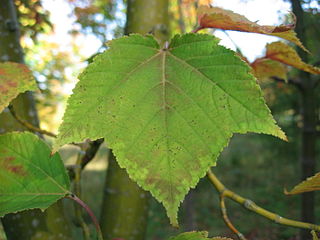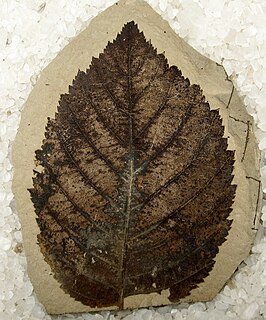
Tilia johnsoni is an extinct species of flowering plant in the family Malvaceae that, as a member of the genus Tilia, is related to modern lindens. The species is known from fossil leaves found in the early Eocene deposits of northern Washington state, United States and a similar aged formation in British Columbia, Canada.

Sassafras hesperia is an extinct species of flowering plant in the family Lauraceae.

Ginkgo dissecta is an extinct ginkgo species in the family Ginkgoaceae described from a series of isolated fossil leaves. The species is known from Early Eocene sediments exposed in the province of British Columbia, Canada, and Washington, USA. It is one of two Ginkgo species found at the Washington and British Columbia sites.
Neviusia dunthornei is an extinct species of flowering plants in the family Rosaceae. The species is solely known from the early Eocene, Ypresian stage, Allenby Formation Lacustrine deposits near the town of Princeton, British Columbia.
Acer stonebergae is an extinct maple species in the family Sapindaceae described from two fossil samaras. The species is solely known from the Early Eocene sediments exposed in northeast Washington state, United States, and the adjacent area of south central British Columbia, Canada. It is one of three species belonging to the extinct section Torada.
Acer toradense is an extinct maple species in the family Sapindaceae described from two fossil samaras. The species is solely known from the Early Eocene sediments exposed in northeast Washington state, United States, and the adjacent area of south central British Columbia, Canada. It is one of three species belonging to the extinct section Torada.
Acer washingtonense is an extinct maple species in the family Sapindaceae described from one fossil leaf and four fossil samaras. The species is solely known from the Early Eocene sediments exposed in northeast Washington state, United States. It is one of three species belonging to the extinct section Torada.
Acer stewarti is an extinct maple species in the family Sapindaceae described from a series of fossil leaves and samaras. The species is solely known from the Early Eocene sediments exposed in south central British Columbia, Canada adjacent to northeast Washington state, United States. It is one of only two species belonging to the extinct section Stewarta.
Acer browni is an extinct maple species in the family Sapindaceae described from a series of isolated fossil leaves and samaras. The species is known from the early to middle Miocene sediments exposed in Western Oregon, Washington state, USA and Northern Graham Island, Haida Gwaii, Canada. It is one of several extinct species placed in the living section Parviflora.
Acer ashwilli is an extinct maple species in the family Sapindaceae described from a group of fossil leaves and samaras. The species is solely known from the Early Oligocene sediments exposed in central Oregon, USA. It is one of several extinct species belonging to the living section Ginnala.
Acer clarnoense is an extinct maple species in the family Sapindaceae described from a series of isolated fossil leaves and samaras. The species is known from the late Eocene sediments exposed in the state of Oregon in the US. It is one of several extinct species placed in the living section Macrantha.

Acer latahense is an extinct maple species in the family Sapindaceae described from series of isolated fossil leaves. The species is known from the latest early to middle Miocene sediments exposed in the states of Oregon and Washington, USA. It is one of several extinct species placed in the living section Macrantha.

Fothergilla malloryi is an extinct species of flowering plant in the family Hamamelidaceae known from fossil leaves found in the early Eocene Klondike Mountain Formation deposits of northern Washington state. The F. malloryi leaves are the earliest appearance in the fossil record of a member of the witchalder genus Fothergilla, which includes the living species F. gardenii, and F. major, both of which are native to the southeastern United States. The genus also includes three or four other fossil species with two Asian Miocene species, F. viburnifolia from China, F. ryozenensis from Japan along with one Miocene North American species, F. praeolata of Oregon. Fothergilla durhamensis described from Eocene sediments in King County, Washington is considered dubious in placement, and it was transferred to the genus Platimeliphyllum by Huegele et al. (2021).

Orontium wolfei is an extinct golden-club species in the family Araceae described from a series of isolated fossil leaves. The species is known from Eocene sediments exposed in the state of Washington in the United States of America and the province of British Columbia in Canada. It is one of several extinct species placed in the living golden-club genus Orontium.

Rhus malloryi is an extinct species of flowering plant in the sumac family Anacardiaceae. The species is known from fossil leaves found in the early Eocene deposits of northern Washington state, United States. The species was first described from a series of isolated fossil leaves in shale. R. malloryi is one of four sumac species to be described from the Klondike Mountain Formation, and forms a hybrid complex with the other three species.

| authority = Wolfe & Wehr Langeria is an extinct genus of flowering plants in the family Platanaceae containing the solitary species Langeria magnifica. Langeria is known from fossil leaves found in the early Eocene deposits of northern Washington state, United States and similar aged formations in British Columbia, Canada.

Tsukada is an extinct genus of flowering plant in the family Nyssaceae related to the modern "dove-tree", Davidia involucrata, containing the single species Tsukada davidiifolia. The genus is known from fossil leaves found in the early Eocene deposits of northern Washington state, United States and a similar aged formation in British Columbia, Canada.

Betula leopoldae is an extinct species of birch in the family Betulaceae. The species is known from fossil leaves, catkins, and inflorescences found in the early Eocene deposits of northern Washington state, United States, and similar aged formations in British Columbia, Canada. The species is placed as basal in Betula, either as a stem group species, or an early divergent species.

Tetracentron hopkinsii is an extinct species of flowering plant in the family Trochodendraceae. The species is known from fossil leaves found in the early Eocene deposits of northern Washington state, United States and south Central British Columbia. The species was first described from fossil leaves found in the Allenby Formation. T. hopkinsii are possibly the leaves belonging to the extinct trochodendraceous fruits Pentacentron sternhartae.

Comptonia columbiana is an extinct species of sweet fern in the flowering plant family Myricaceae. The species is known from fossil leaves found in the early Eocene deposits of central to southern British Columbia, Canada, plus northern Washington state, United States, and, tentatively, the late Eocene of Southern Idaho and Earliest Oligocene of Oregon, United States.












